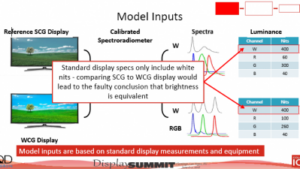
Peter Kazlas is from QD Vision and he gave a brief introduction to his company and QD technology. He talked about the 3M research that showed that some consumers prefer HDR and better colour to more resolution. Rec 2020 can only really be achieved with QDs (at 97%). The saturated emitters are more efficient than other WCG technologies like OLED, he said.
If you take a YAG LED LCD and compare to a QD display, you get different numbers. Assuming the same number of photons, the QD shows 16% fewer nits, because of the photopic response. However, if consumers see the display, the HK effect kicks in and they would like the QD one more.

QD Vision believes that an HK-corrected brightness should be used. ColorNits uses standard methods to measure, then you calculate to take account of the photopic response issue, then apply a calculation to allow for the HK effect.
An example calculation showed a perceptual brightness advantage of around 30% for a WCG QD display. The resulting number would be called ‘ColorNits’
QD Vision wants to encourage companies such as SpectraCal and X-Rite to include the measurement in their systems.
Analyst Comment
This was kind of strange. Kazlas’s contention that somehow using the photonic response is ‘wrong’ is a bold assertion, but he gave no real evidence. The candela is a well-established measure and is an SI base unit of luminance and takes account of the response. You’d have to have some compelling evidence to use something else.
I can understand that it would suit QD suppliers (and others) to have a way to reflect the H-K effect, but this doesn’t look like it, which is a shame. We spoke to a member of the ICDM about the metric, and he, basically, poured scorn on the metric and told us that the presentation was confusing its terms, such as luminance and brightness and that really made him very nervous.

